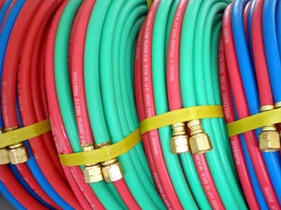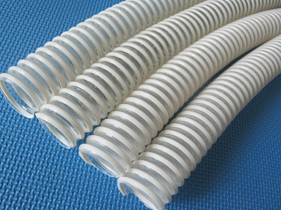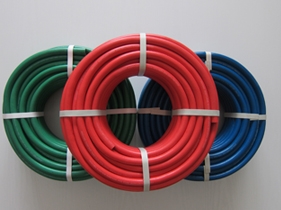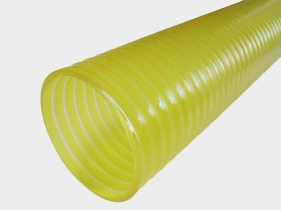
Jiaozuo production In places that must be crossed or may rub with the mechanical surface when working, hose clamps or springs and other protective devices should be used to prevent the outer layer of the sandblasting hose from being damaged. Sand blasting hose shall be arranged to avoid heat source as far as possible and away from the performance of engine exhaust pipe. If necessary, sleeve or protective screen can be used to prevent the hose from being heated and deteriorated. When the sand blasting hose must be bent, the bending radius should not be too small, and should be greater than 9 times the outer diameter. There should be a straight line section greater than 2 times the outer diameter of the pipe at the joint between the rubber hose and the joint. How high-quality the products and equipment we use are, it is inevitable that there will be some large and small failures in the process of using them, which will more or less have a certain impact on our work. Just like the use of sandblasting hose, there are traces of its outer adhesive seam, problems must be solved, For this, we explained the following solutions: First, the used water cloth should be used according to the original elastic edge of the water cloth when it is reused. 2: When we wrap the water cloth around the seam of the sandblasting hose, we should apply sufficient and uniform pressure to the pipe body. 3. The water cloth with different widths should be selected according to the size of the outer diameter of the wrapped sandblasting hose (for hose with an outer diameter of less than 30mm, the width of the water cloth should not exceed 90mm). The overlapping width of the water cloth should be 3/5-2/3 of the width of the water cloth.

production Sand suction hose The inner rubber layer of( ф 0.3-2.0 reinforcement layer) is the skeleton material that plays the role of reinforcement. What should be paid attention to when storing the wear-resistant sandblasting pipe. 1. The wear-resistant sandblasting pipe should be stored as loose as possible. Generally, rubber hoses with inner diameter less than 76 mm can be wound and stored. 2. During the storage of wear-resistant sand blasting pipe, it is strictly prohibited to stack heavy objects on the pipe body to prevent external extrusion and damage. 3. During the storage of wear-resistant sand blasting pipe, do not contact with acid, alkali, oil, organic solvent or other corrosive liquids and gases, and the heat release should start from 1m away. 4. The storage period of wear-resistant sand blasting pipe shall not exceed 2 years. It shall be used by the first person to prevent the quality of rubber hose from being affected by long-term storage. 5. When wear-resistant sand blasting pipes need to be temporarily stored in the open air, the site should be flat and the rubber pipe should be laid flat. The upper cover should be placed under the rubber pipe and no heavy objects should be stacked. At the same time, the hose shall not contact the heat source. 6. The storage place of the upper and lower rubber pipes in the well shall be kept clean and ventilated, and the relative humidity shall be 80. The temperature of the storage place shall be kept between - 15 ℃ and 40 ℃, and the rubber pipe shall be protected from direct sunlight and water spray. 7. When storing wear-resistant sand blasting pipe, Sand suction hose Where can I find it? Both ends of the hose shall be sealed firmly to prevent sundries from entering the hose. 8. When the wear-resistant sand blasting pipe is stored, it should be placed separately according to different varieties and specifications, not mixed, and hang a management board. 9. In order to prevent the pipes from being pressed and deformed during storage, they should not be stacked too high, and the stacking height should not exceed 1.5m. It also requires rubber hoses to be "stacked" frequently during storage, at least once a quarter.

production Sand suction hose It is a key component of any hydraulic system. When they fail, everything will stop. The preventive maintenance of the metal sandblasting hose is very important and needs to be checked regularly in order to find problems before starting. This may include checking hose caps and fittings, and looking for other signs of leaks and impending hose failure. The more strict the hose inspection process, the more reliable your equipment will be. 1. Benefits of preventive maintenance of metal sandblasting hoses: preventive maintenance of metal sandblasting hoses and equipment is always better than reactive maintenance. One reason is that it can make your equipment run efficiently by solving problems before they fail and have a significant negative impact on the system. Contrary to what many people think, preventive maintenance means reducing downtime due to unexpected component and system failures. Attention to maintenance can also extend the expected life of equipment, maximize its economic value, and minimize potential safety hazards to personnel. Finally, preventive maintenance can reduce maintenance costs and unnecessary equipment procurement. Not participating in regular preventive maintenance can be an expensive decision. 2. Maintenance time of metal sandblasting hose: Sand suction hose Where can I find it? Part of the preventive maintenance program for solid metal sandblasting hoses includes periodic inspection of metal sandblasting hoses. Fixed equipment shall be inspected every three months. For mobile equipment, hose inspection shall be conducted every three months or every 400 to 600 hours, whichever comes first.

Jiaozuo Sand suction hose Structure type of product: sand blasting hose is mainly composed of liquid resistant inner rubber layer, middle rubber layer, 2 or 4 or 6 layers of steel wire winding reinforcement layer and outer rubber layer. The inner rubber layer has the function of bearing the pressure of the transmission medium and protecting the steel wire from erosion, the outer rubber layer protects the steel wire from damage, and the steel wire (0.3-2.0 steel wire) layer is the reinforced skeleton material. Application of sandblasting hose products: high-pressure sandblasting hose is mainly used for mining hydraulic support and oil field exploitation, and is suitable for engineering construction, lifting and transportation, metallurgical forging, mining equipment, ships, injection molding machinery, agricultural machinery, various machine tools, and mechanical and automatic hydraulic systems in various industrial sectors to transport petroleum base with a certain pressure (higher pressure) and temperature. (such as mineral oil, soluble oil, hydraulic oil, fuel oil, lubricating oil) and water-based liquid (such as emulsion, oil-water emulsion, water). And liquid transmission. The working withstand voltage can reach 70-100 MPa. The company's sand blasting hose standards refer to national standards/T10544-03, DIN 20023, and SaE100 R9-13. Sand suction hose Where can I find it? Made of special synthetic rubber, it has excellent oil resistance, heat resistance and aging resistance. The rubber hose has high bearing pressure and superior pulse performance. The tube body is tightly combined, soft to use, and has little compression deformation. The hose has excellent bending resistance and fatigue resistance. The sandblasting hose is 20m long and can be made within 50m as required.






